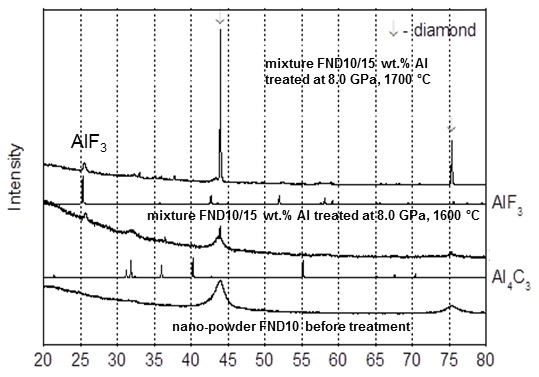NANOSYSTEMS: PHYSICS, CHEMISTRY, MATHEMATICS, 2018, 9 (1), P. 25–28
Phase stability of fluorinated nanodiamonds under HPHT treatment
V. N. Khabashesku – Center for Technology Innovation, Baker Hughes a GE Company, Houston, TX, USA; valery.khabashesku@bakerhughes.com
V. P. Filonenko – Vereshchagin Institute for High Pressure Physics RAS, Moscow, Troitsk, Russia; filv@hppi.troitsk.ru
A. S. Anokhin – A. A. Baikov Institute of Metallurgy and Materials Science RAS, Moscow, Russia; alexanderanokhin@yahoo.com
E.V. Kukueva – Lomonosov Moscow State University, Moscow, Russia; elena.kukueva@gmail.com
The aspects of phase and size stability of surface fluorinated nanoscale diamond powders during their treatment under conditions of high pressures and high temperatures (HPHT) are considered. In the studied powder, fluorine is covalently bonded to diamond particles, replacing the other functional groups on their surface. In this case, under pressure of 8.0 GPa the transition of 10-nm-size diamond nanoparticles into a graphene layered carbon forms does not occur up to temperatures of 1700 °C, and their size does not change. The addition of submicro-sized aluminum powder to fluorinated nanodiamond results in the fast growth of particles to a micrometer size range. The observed unprecedented enlargement of nanodiamonds to micro-sized crystals is explained by occurrences of Wurtz-type reactions in the C–Al–F system which activate the formation of new interfacial carbon–carbon bonds between nanoparticles and their coalescence under HPHT conditions.
Keywords: fluorinated nanodiamonds, high pressure-high temperature treatment, aluminum fluoride.
PACS 62.50.-p, 81.07.-b, 81.05.ug
DOI 10.17586/2220-8054-2018-9-1-25-28
